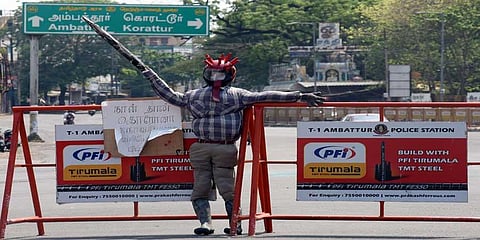

CHENNAI: COVID-19 cases in Chennai have breached the 1,000-mark. Of them, a whopping 511 cases — over half the number — were reported in the last four days. This is in sharp contrast with the rest of the State, where cases have been dwindling over the last two weeks. What is working against Chennai? Also, why has there been a meteoric rise despite the lockdown being in force since March 24?
Leaky lockdown
Virologist T Jacob John suspects this is because the lockdown was not implemented or followed in the true spirit. “The government need not defend the numbers during a naturally occurring disease,” says John. “However, now that there is a lockdown in place and all persons stepping outside have been asked to wear a mask, if at all there is an increase in transmission it must be minimal.”
John says the problem is that only the government is fighting the virus. The public are mere spectators. “We have failed in informing the public on what the problem is, and how they can participate in containing it.” One reason for the sporadic increase, John feels, is because people are not wearing masks though they are supposed to do so.
An interesting observation is that the alarming rise in numbers happened right after the ‘intensified’ four-day lockdown period ended. The Saturday before the ‘intensified’ lockdown, thousands thronged marketplaces, shops, and eateries to stock up on essentials fearing the worst. The footfall at Koyambedu Wholesale Market, which soon became a COVID-19 hotspot, was extremely high.
The test match
Epidemiologist G Kuganatham says the best way to control an epidemic outbreak is by ramping up testing, with a focus on the critically ill. “Another reason for Chennai alone witnessing such high numbers is the population density. This adds to the crowds and movement witnessed at places such as Koyambedu Market,” says Kuganatham.
Corporation Commissioner G Prakash also attributes it to population density. “When an average of 24,000 people are supposed to live within a square kilometre, in Chennai we have 50,000 people living in the same area.” This reasoning is backed by data. Highly congested neighbourhoods of North Chennai have witnessed far more cases that the posh, well-developed East or South.
Three zones of Tondiarpet, Royapuram, and Tiru-Vi-Ka Nagar alone account for over half the total number of cases (53.64 per cent). As on Friday, Tiru Vi Ka Nagar (210) had overtaken Royapuram (199). Tondiarpet, the neighbouring area, is much behind with 77 cases. So far 19 frontline corporation workers have been infected. They were all, ironically, engaged in disinfecting the city.
Prakash says monitoring has been enhanced in critical zones, such as Ayanavaram, Pulianthope, and the three mentioned above. “We would also remove containment measures taken in areas where no new cases have been recorded over the last 28 days.” The city now has 231 containment areas, as opposed to 202 on Tuesday. Experts, however, say officials have to move past containment and accept the reality of community transmission.
The transmission realisation
“I believe that we are now past the containment stage, and have gone into community transmission,” says Jayaprakash Muliyil, chairman of the Scientific Advisory Committee at the National Institute of Epidemiology. He says contacts of positive patients need not be subjected to the same level of treatment. It’s time to switch gears.
“The contacts, even if they are positive, can be isolated at their own homes. They may be advised to come to hospitals only if they develop symptoms.” He suggests separate categories for patients with and without symptoms. It is this lack of categorisation that is making the numbers seem high, says Muliyil.
“Putting them in the same category may have made sense in the containment stage. But now, I believe, we are well past that and gone into community transmission.” The focus, he says, must be on those with symptoms so that the mortality rates can be controlled. Doctors and practitioners agree with Muliyil’s observations.
The permanent solution
It’s true that without the lockdown, the numbers could have gone much higher. “However, it’s important to remember that lockdown is a temporary solution, primarily to prevent acute overcrowding in hospitals,” says doctor Ram Gopalakrishnan, who treats infectious diseases at Apollo Hospitals.“Going forward, the focus must be on protecting the vulnerable and the elderly, who may continue to remain in a state of semi-lockdown. The rest of us can move about while following cough hygiene, wearing masks, and maintaining the 2-metre distance rule,” says Gopalakrishnan.